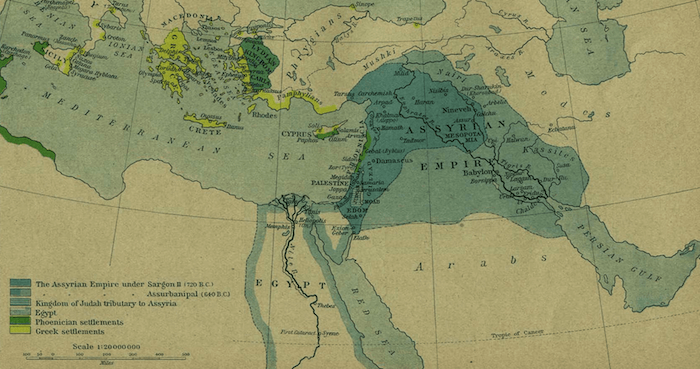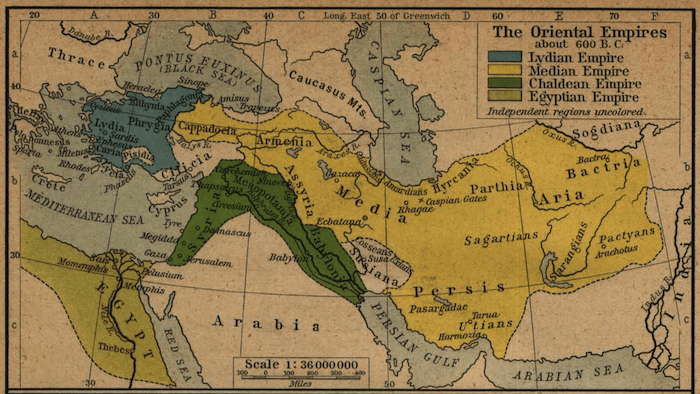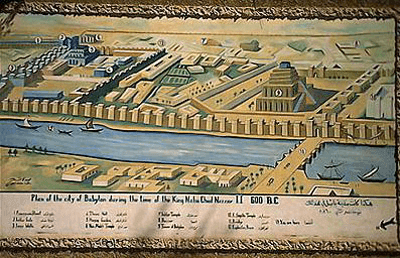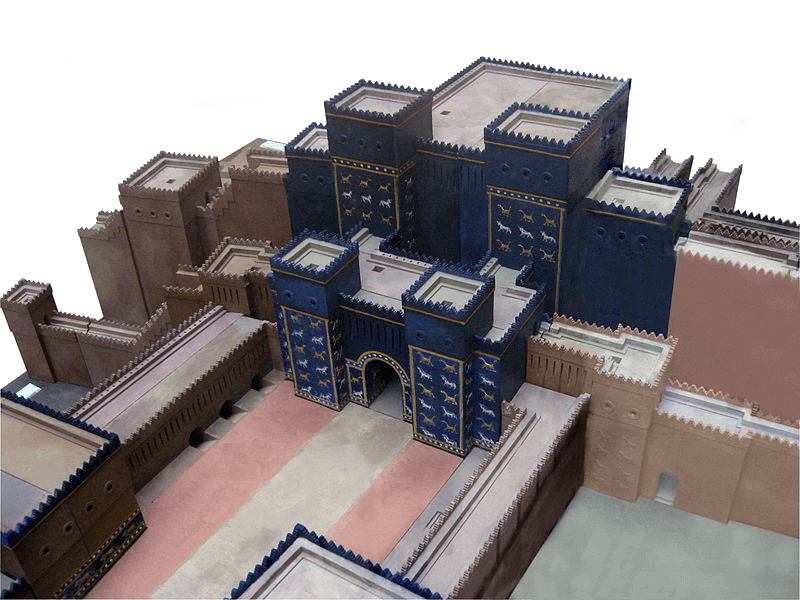Cultures > Babylonia > Neo-Babylonian Empire
Neo-Babylonian Empire

Background
By 620 BC many elements within Babylonia had enough with the Assyrian rulers. A revolution began and soon spread to nearly every city and city-state within the civilization except some in the north that remained loyal to Assyria. While Nabopolassar was easily able to claim power over most of Babylonia, he still had to deal with the Assyrian army that was camped in the north based around Nineveh, Ashur and Nippur which posed a constant threat to his rule. Despite wishing to regain rule over their territory, this period coincided with a decline in Assyrian political power.

Nabopolassar
During this period Assyria was undergoing a series of revolutions and king Sin-shar-ishkun was under constant threat from his own people to worry too much about Babylonia. In 615 BC the tide was turned for Neo-Babylonia as Nabopolassar created a diplomatic alliance between the Chaldeans, Babylonians, Scythians, Cimmerians, Lydians, Medes, Persians and Parthians. The Scythians and Cimmerians people were all formally vassal states of Assyria and were eager to join the fight against their old tyrant.

Assyrian Empire Map (750-625 BC) - Historical Atlas (1923)
In 615 BC the Medes under Cyaxares launched a surprise assault on Assyria at the cities of Arapha and Nimrud while the king was in the middle of a revolution of his own. The Medes were soon joined by an overwhelming alliance led by Nabopolassar and they fully went to war with the civil war that was already going on in Assyria. The coalition was able to capture many cities such as Ashur, Arbela, Guzana, Khorsabad, Imgur-Enlil, Tushhan, Nibarti-Ashur, Kar Ashurnasipal, and many others in 614 BC.

Babylon - (1906)
Against all odds the Assyrian king Sin-shar-ishkun was able to fight back both the rebels and the invaders and temporarily seemed to gain control over Assyria. However, the alliance struck back once again in 612 BC and there was a near total devastation of Assyria, including the complete destruction of their capital at Nineveh following the siege known as the Battle of Nineveh. This occurred with prolonged street to street fighting and eventually Sin-shar-ishkun was killed while defending his palace.
Following the death of the Assyrian king there was house to house fighting that continued in Nineveh as the Babylonians and Medes back sacking and looting the city. In the aftermath Ashur-uballit II who was a general from the royal family took the throne and was offered the position of vassal by the coalition leaders Nabopolassar and Cyaxares according to the Babylon Chronicle. However, he refused to kneel and along with a contingent of soldiers managed to fight his way out of the city and fled west to the countryside.
Fall of Harran
The remnants of the Assyrian military and elite fled to the city of Harran and established a new capital. From there they prepared for the Babylonian and Median invaders and were able to hold off their assault until 608 BC. Following their victory in Nineveh, the Babylonian and Mede forces stormed towards Harran and once again defeated the Assyrians after a prolonged siege what became known as the Fall of Harran.
Routing the forces, this pushed the Assyrians even further back to the city of Carchemish which lay on the outer most rim of their territory. After the Assyrian forces recuperated they attempted to launch an invasion of Harran in order to take back the city and gain momentum to reclaim their territory. The Babylonians and Medes repelled them from the region and Nabopolassar sent his son Nebuchadnezzar II to personally decimate the Assyrians for good.
Battle of Carchemish
Calling upon their Egyptian allies, the Assyrians were fighting for the very survival of their civilization. Mustering a mercenary force under leader Necho II, the Egyptians rallied to the cause of the Assyrians and began to march north. Necho II had been installed as a vassal ruler in 671 BC and possibly believed it was in his own best interest to aid the Assyrians because if not he was surely next.
It was to be of no use, the Egyptians and Assyrians were crushed in the Battle of Carchemish. The Assyrian forces were massacred and the Egyptians were forced to flee the city back to their homeland. This did not stop them from sacking the Kingdom of Judah on the way back to help offset their losses in Carchemish. However, the result was clear. Babylonia was the defacto dominating power in the region of Mesopotamia and with his fathers failing health Nebuchadnezzar rushed home to secure his rule and consolidate power. This is first time in one thousand years since the reign of Hammurabi that the Babylonians held the seat of power in the ancient world.
Nebuchadnezzar II
Nebuchadnezzar II (605–561 BC) was the oldest son of Nabopolassar and easily the most memorable and successful king of Babylonia besides Hammurabi. While his father managed expel Assyrian rule from Mesopotamia it would be Nebuchadnezzar that would build the Babylon that we come to imagine, launching the most adventurous building projects of the era. He renovated and updated the canals, aqueducts, temples and reservoirs of the city and also constructed some of the greatest structures the ancient world had ever seen. His father would die shortly after he returned to the capital on Aug. 16, 605 and left Nebuchadnezzar in control of the massive empire.

Nebuchadnezzar II Drawing
He ascended the throne within three weeks and set in motion all of the plans to expand Babylon and then began a series of military conquests to expand the empire. Between June to December of 604 BC the Babylonians along with Greek mercenaries invaded Kingdom of Judah and sacked the city of Jerusalem. He also seized the city of Ashkelon. He subdued the Jews and the leader Jehoiakim (608-598 BC) changed allegiance from the Egyptians to the Babylonians by paying a tribute of gold, temple artifacts and some of the royal elite to be used as hostages.

Mesopotamian Empires 600 BC - Historical Atlas (1923)
Starting again in 600 BC he attempted to launch a military invasion in order to acquire the territory into his empire like Assyria previously had. However, he was unsuccessful and Jehoiakim decided to switch allegiance back to the Egyptians and stopped paying tribute to Nebuchadnezzar. The Babylonians would return home to repair their chariots and a year later in 599 BC he would prepare for another campaign to reclaim Judah. From December of 599 BC to March of 598 BC he launched an attach on the Arab tribes living in Arabia as he planned to move straight across the plain.

Nebuchadnezzar II in the Hanging Gardens - Ernest Wellcousins
Following this he successfully attacked and claimed Judah on March 16th, 597 BC and deported Jeconiah/Jehoiachin back to Babylon. He installed the brother of Jehoiakim named Zedekiah and continued to campaign in the western region between 596 BC and 595 BC. However, a rebellion in the eastern portion of the empire possibly Elam forced him to return back to Babylon. Following this there was a rebellion within his own army between 595 BC and 594 BC that he was forced to quash launching two more campaigns later that year.

Nebuchadnezzar II Plundering - Neville Dear
Nebuchadnezzar's next military activities are not well known from his Chronicles but can possibly be inferred from the Bible. He attempted another invasion of Egypt between 587 and 586 BC but was ultimately unsuccessful. He turned his attention next to the Kingdom of Judah once again and sieged the city between 587 BC and 586 BC. After being successful he deported all of the prominent Jewish citizens and the rest of the population back to Babylon between 586 BC and 582 BC. This was the end of the Kingdom of Judah once and for all and the Jews would remain in Babylon until being liberated by Cyrus the Great and the Achaemenid Empire.

Nebuchadnezzar II Overlooking Babylon
Nebuchadnezzar II would be forced to return home to consolidate his eastern border from the increasing power of the Medes, Cimmerians and Scythians. He married the daughter of the Median king named Amytis in order to create political stability between the two empires and allowed Babylonia to flourish. Following this he began military campaigns to conquer Phoenicia and Egypt.

Babylonian Siege of Tyre
After the destruction of Jerusalem and the siege of Judah the Babylonian army would move towards Tyre and attempt a siege of the great wealthy Phoenician city on the eastern Mediterranean. Between the years of 586 BC and 573 BC Nebuchadnezzar would attempt to siege the city but ultimately be unsuccessful. It ended in a compromise that led to the Tyrians agreeing to pay the Babylonians tribute and accept their authority in exchange for not interfering with their trade routes on the Mediterranean Sea. Following Tyre the Babylonian armies turned their attention towards Egypt and the last remnant Assyrian vassal leader Necho II. According to a clay tablet that now resides in the British Museum, the conquest went as follows.
"In the 37th year of Nebuchadnezzar, king of the country of Babylon, he went to Mitzraim (Egypt) to wage war. Amasis, king of Egypt, collected [his army], and marched and spread abroad."
Nebuchadnezzar went to war once again with the Egyptians who were ruled by king Amasis II but he was ultimately unsuccessful in ridding Egypt of the Assyrian vassal rule and returned back to Babylon to oversee his massive construction projects. He married queen Amytis of Media in order to secure stability between the two empires and would reign for the rest of his life in prosperity. Nebuchadnezzar would die in 561 BC and be succeeded by his son Awil-Marduk (Evil-Merodach of 2 Kings).
Golden Age of Babylonia
When Nabopolassar managed to regain Chaldean control over he did not inherit the beautiful Babylon that we imagine today. After the many revolutions throughout the years the city had been greatly damaged. However, Nebuchadnezzar II was able to restore the city and literally made the entire city on massive world wonder. He restored all of the old temples, built and restored aqueducts and irrigation systems along with expanding the boundaries of the city and its defensive structures.
In fact, the new walls that Nebuchadnezzar would build would be virtually impregnable to any siege tower of the day, an obvious necessity in the war torn Mesopotamia. The regular people of Babylonia would prosper as well as new trade goods were once again brought from all throughout the Neo-Babylonian Empire along with the Median Empire all the way to India.

Babylon Map - Ishtar Gate Mural (600 BC)
Babylonian Structures
Nebuchadnezzar's Palace
The royal palace that Nebuchadnezzar II built was one of the grandest in all of the ancient world. It was decorated with cedar from Phoenicia, bronze, gold and silver from throughout the empire and all kinds of precious stones and gems.
Etemenaki
Walls of Babylon
The Walls of Babylon were a feat in and of themselves. Built in a triple line formation surrounded by a moat, these walls were virtually impregnable by any sort of siege machine at the time. They were lined with turrets and towers and garrisoned with archers and soldiers that could spot an invading army miles away. The walls were so wide that two chariots could race around on top of them and were known to never have been breached directly.
Ishtar Gate
Guarding the Processional Way and the inner most walls before Nebuchadezzar's Palace was the fabulous Ishtar Gate. The Ishtar Gate was constructed with magnificent blue glazed bricks and adorned with all sorts of animal reliefs and decorations. The process of glazing the bricks blue is a chemistry and engineering feat in and of itself.

Ishtar Gate Digital Model
Esaggila
The Esaggila was a massive temple to the main Babylonian god known as Marduk. It was a grand temple and extremely important in Babylonian culture and tradition.
Hanging Gardens of Babylon

Hanging Gardens of Babylon - Ferdinand Knab (1886)
According to the historian Berossus with building one of the Seven Wonders of the World known as the Hanging Gardens of Babylon. According to the ancient account he built it for his homesick wife Amytis who longed for the flora of her homeland but in reality it was a tradition that dated far back into Assyrian-Babylonian culture all the way back to Sargon the Great and possibly Sumer.
Decline
Following the rule of Nebuchadnezzar the civilization of Babylonia would decline. This is actually what Nebuchadnezzar prophecized, the same as Hammurabi before him based on the accounts of Berossus, Abydenus (Eusebius) and Praeparatio Evangelica (9.41). He would die in Babylon between the second and sixth month of the 43rd year of his reign over Babylonia. His successor Amel-Marduk would only reign for two years and there is not much record of his reign.
He was removed from the throne by Neriglissar (560–556 BC) in 560 BC who also had a short reign of only six years. He was the son in law to Nebuchadnezzar and apparently removed Amel-Marduk because of incompetence or improper behavior. He launched a few successful military campaigns into Aram and Phoenicia and was succeeded by his son Labashi-Marduk who was the last of the Chaldean kings and only ruled for a single year before being assassinated by a palace conspiracy. He was replaced by Nabonidus (556–539 BC) who was responsible for killing Labashi-Marduk and seizing the throne.

Belshazzar Drawing
Nabonius was the son of an Assyrian priestess named Adda-Guppi originally from the city of Harran. Most of the rule of Nabonius is known from a clay tablet called the Annals of Nabonius and a few other sources. He is most famous for being the last king of Babylonia before the civilization was finally conquered. There were many different factors that led to the complete collapse of Babylonia once and for all. He left the day to day operations of the city to his son Belshazzar who was a very good soldier but not an effective political ruler.
This cause internal conflict between the elite and also the population as a whole. Nabonius attempted to centralize the religion of Babylon into the single Temple of Marduk and this upset a lot of the various tribes who practiced a multitude of different religions in the ancient world. Nabonius spent a lot of time outside of Babylonia and rebuilt temples in his home city of Harran before taking a nearly decade long expedition to Arabia and also excavated the foundations of many temples in order to discern their records. This made him seem ineffective as he was not there to directly rule the empire.